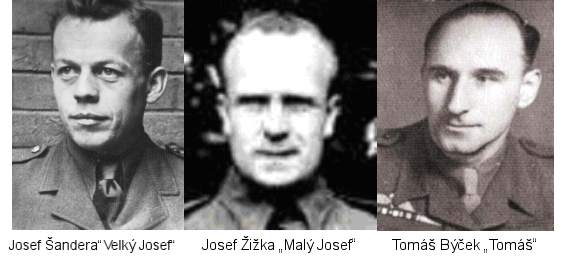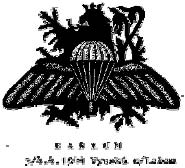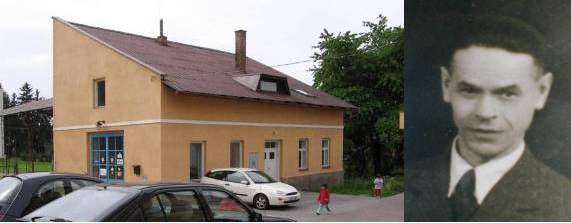BARIUM - Part One
Categories: Wars
In order to connect the guerrilla groups with London, during the Second World War, the Czechoslovakia, steamships with specially trained soldiers of the former Czechoslovak army were deployed. One of the paratroopers that was dropped over our territory was the Barium paratroop, commanded by Sgt. Josef Šandera. It was dropped on the night of 3 to 4 April 1944 and was to operate in the north-eastern Bohemia in the area of Hradec Králové, Rychnov and Žambersek.


Most of the radios were registered and bugged by German intelligence immediately after the drop and after the first transmission sessions. The German authorities understandably wanted to liquidate these para-groups with radios, or to force them to cooperate in a so-called "counter-game".
Transcript of the testimony of paratrooper Tomáš Býček (code name "Tomáš" and "Olda")
On April 3, 1944, we parachuted at 23.15 near Vysoká nad Labem. After the jump we were all well. We decide to throw the parachutes and packing material into the Elbe. Zizka and I carry them twice, while Sgt. Šandera prepared the shock absorbers with the connecting material. During this work a military fighter flies over us. Around three o'clock and thirty minutes we leave with all the material in the direction of Holice, where we decide to look up the address of Vohralik, a shoemaker from Stary Holice. We cross the state road and after splitting up we camp in the woods behind Bašta, where we await the evening. I suggest burying half of the fasteners, considering that we each have a load of over 25kg. Shandera orders to carry all the material. In the morning we reach the road to Borohrádek on the forest clearing near Poběžovice and lie down. At eight o'clock Šandera sets out to find the addresses Vohralík - Holice and Fidrhel - Dolní Roveň, recommended by Minister Laušman. He returns, having been rejected by both Vohralík and Fidrhel. We have confidence in the addresses and decide as follows: Žižka, who is a Czech brother and has a well-known Czech parish priest, Reichl, in Potštejn, goes to Potštejn. Šandera and I return to Hradec to look for the address of F. Klazan, Hradec Králové - the parsonage. We bury all the material except food and part. In the morning we camp at Borovnice near Hradec and Šandera goes to look for Klazan's address.
He found the house, but Klaban is in a reformatory. He finds only a lady and a son. At first they trust him, but later, after consulting with the father of the German minister, they become cautious and Klaban's son accompanies Šandera to the forest to fetch me, where he convinces him of our truth. He is convinced, and in the evening he brings with him the gardener František Němec, who puts us in the fence of his garden hut by the track. Klaban's son asks us not to go to them anymore, because he is under the control of the Gestapo. For four days we slept again under the roof in soaked sleeping bags. The next day Mr. Nemec's daughter Růženka comes and cooks coffee and dries the laundry for us. On White Saturday the German procures bicycles for us and we leave for Vysoké Chvojno to get fasteners. Here we find that Vohralik (contact imported from Britain strictly controlled, vetted and selected in advance. Our "nice" feature! We decide to support Žižka. We go to Potštejn and Šandera and Nemec go back to Hradec. In Potštejn, the preacher Reicherák is no longer alive, he was executed by the Gestapo, but Žižka finds here the parish priest Zvěřina, whomHe also knows him personally and is recommended to the Vilímek family in Častolovice, where he stays overnight and is again sent to Slemena to Rohlen. Rohlena hid Žižka, provided them with shelter in a nearby hájnica and a place for a radio at Lokajíček in Rychnov.

Contemporary photograph of the house where the radio was hidden by Marta and a photograph of František Lokajíček.
We decide to move half of the machinery (i.e. the Simandl transmitter and M5 receiver) to Slemena. We leave at Resurrection, find the material happily in the forest near Poběžovice and take it back to Slemena via Borohrádek, Kostelec n.O. For safety reasons, we throw the casted boxes into the Orlice River (if this is still happening in the vicinity of Slemena, the mentioned river was the Kněžná. Both the place of the event and the historian Josef Krám speak for Kněžná in his guidebook. However, the act of overthrowing the box, which had been welded in England and contained, among other things, the radio Marta, was fatal for the subsequent development of the situation! Read more.... Author's note) We spend the night at the Rohlens' and on Christmas Day we return to Hradec to the Germans. In the meantime, the German has provided us with an apartment with Officer Míčanek in Nové Hradec, where we sleep for the first time on St. Stephen's Day. The second apartment we have secured at the mechanic Bedrich Marek's in Pražské Předměstí, where Šandera is sleeping the next night, and the third at the letter carrier J. Lánský from Svobodné Dvory, where I will also sleep.
END OF THE FIRST PART.
Wobber
Used literature:
Emil Trojan: Tak osahali... (Partisan resistance in the Orlické Mountains 1939 - 1945, year of publication 2002
PhDr. Josef Krám: Kněženskorychnov Guide http://www.rychnovskypruvodce.info/
You can search for artefacts from World War II using our metal detectors.
The article is included in categories: